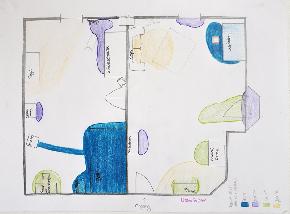FUNDAMENTALS OF THREE-DIMENSIONAL ART
Introductory seminar at the Institute for Art Pedagogy, JLU, Gießen (2012)
In this introductory seminar the foundations of three-dimensional art are explained as the experience and representation of space and spatial extension in relationship to the human body. Three phases can be distinguished in the process of creating three-dimensional art: the physical experience of space, the free shaping of space and construction. Experiencing space, shaping space and visualizing space represent the three fundamental prerequisites for creating three-dimensional forms.
Constructing and visualizing space are closely related to individual and physical experience.
We understand by unconsciously comparing what we see with what we already know or have experienced. A right angle cannot be perceived without a mental construct which allows us to correct what we have perceived. Space can be formed only through the dialectic interplay of knowledge, certainty and spontaneous experience. The seminar is divided into four phases that interlink the experience of space with the visualizing and shaping of space.
1. In the first part of the seminar all the students draw the floor plan of their private living quarters. The colour values and markings in the floor plans distinguish the various areas on the basis of high, middle or low usage. A cartographical drawing represents the individual experience of a specific space.
2. In the second phase the furniture of the seminar room is used as construction elements to create smaller spaces. The participants work in groups to experience cooperation and interaction with one another. What is interesting for the group, what decisions are made, what is rejected? Relying on the memories of the group members, their work is reconstructed in drawings at a later point in time.
3. The work in the third phase is based on what we know and have learned about space, construction and the platonic solids. Everything can be traced back to these basic forms. Cubes, cylinders, spheres, pyramid, etc., and their sectional forms are used for construction in Euclidian space. Paper as a material is neutral and easy to handle; however, precise considerations are necessary to construct a three-dimensional body from paper.
4. In the fourth phase, material - a mixture of wire, wood, papier-mâché and plaster - is used experimentally to create shapes. The stubborn resistance of the material stands in opposition to the formal idea and the construction of space. Submitting to the stubbornness of the material is one side of the coin, carrying out the formal idea is the other. The working process swings back and forth between these two extremes and is visible in the final results. The vitality of the surfaces creates an emotional quality intensified by the sensory experience.
Introductory seminar at the Institute for Art Pedagogy, JLU, Gießen (2012)
In this introductory seminar the foundations of three-dimensional art are explained as the experience and representation of space and spatial extension in relationship to the human body. Three phases can be distinguished in the process of creating three-dimensional art: the physical experience of space, the free shaping of space and construction. Experiencing space, shaping space and visualizing space represent the three fundamental prerequisites for creating three-dimensional forms.
Constructing and visualizing space are closely related to individual and physical experience.
We understand by unconsciously comparing what we see with what we already know or have experienced. A right angle cannot be perceived without a mental construct which allows us to correct what we have perceived. Space can be formed only through the dialectic interplay of knowledge, certainty and spontaneous experience. The seminar is divided into four phases that interlink the experience of space with the visualizing and shaping of space.
1. In the first part of the seminar all the students draw the floor plan of their private living quarters. The colour values and markings in the floor plans distinguish the various areas on the basis of high, middle or low usage. A cartographical drawing represents the individual experience of a specific space.
2. In the second phase the furniture of the seminar room is used as construction elements to create smaller spaces. The participants work in groups to experience cooperation and interaction with one another. What is interesting for the group, what decisions are made, what is rejected? Relying on the memories of the group members, their work is reconstructed in drawings at a later point in time.
3. The work in the third phase is based on what we know and have learned about space, construction and the platonic solids. Everything can be traced back to these basic forms. Cubes, cylinders, spheres, pyramid, etc., and their sectional forms are used for construction in Euclidian space. Paper as a material is neutral and easy to handle; however, precise considerations are necessary to construct a three-dimensional body from paper.
4. In the fourth phase, material - a mixture of wire, wood, papier-mâché and plaster - is used experimentally to create shapes. The stubborn resistance of the material stands in opposition to the formal idea and the construction of space. Submitting to the stubbornness of the material is one side of the coin, carrying out the formal idea is the other. The working process swings back and forth between these two extremes and is visible in the final results. The vitality of the surfaces creates an emotional quality intensified by the sensory experience.

Students work (Part 1)
Mapping the usage in the private apartement
crayon, pencil on paper
40 x 30 cm, 2011
Mapping the usage in the private apartement
crayon, pencil on paper
40 x 30 cm, 2011